Kutyoka kwemakumbo ndeimwe yemhando dzakajairika dzekutyoka mukiriniki. Kunze kwekukuvara kweGiredhi I/II uye kukuvara kwekutorwa, kutyoka kwemakumbo mazhinji kunowanzo sanganisira lateral malleolus. Kutyoka kwemakumbo kwerudzi rweWeber A/B kunowanzo konzera kusagadzikana kwe distal tibiofibular syndesmosis uye kunogona kuderedza zvakanaka nekuona zvakananga kubva kure kuenda kune proximal. Kusiyana neizvi, kutyoka kwemakumbo kwerudzi rweC-type lateral malleolus kunosanganisira kusagadzikana mu lateral malleolus kuburikidza nema axes matatu nekuda kwekukuvara kwe distal tibiofibular, izvo zvinogona kutungamira kumarudzi matanhatu ekusuduruka: kupfupika/kureba, kuwedzera/kutetepa kwe distal tibiofibular space, anterior/posterior displacement mu sagittal plane, medial/lateral tilt mu coronal plane, rotational displacement, uye musanganiswa wemhando idzi shanu dzekukuvara.
Ongororo dzakawanda dzakapfuura dzakaratidza kuti kupfupisa/kurebesa kunogona kuongororwa kuburikidza nekuongorora chiratidzo cheDime, mutsetse weStenton, uye angle yetibial-gapping, pakati pezvimwe. Kufamba munzvimbo dze coronal ne sagittal kunogona kuongororwa zvakanaka uchishandisa maonero e frontal ne lateral fluoroscopic; zvisinei, kufamba kwe rotational ndiko kwakaoma zvikuru kuongorora panguva yekuvhiyiwa.
Dambudziko rekuongorora kutenderera kwemasero rinonyanya kuoneka mukudzikira kwe fibula kana uchiisa sikuruu ye distal tibiofibular. Mabhuku mazhinji anoratidza kuti mushure mekuiswa sikuruu ye distal tibiofibular, pane mukana wekudzikira kwakaderera we25%-50%, zvichikonzera malunion uye fixation ye fibular deformities. Dzimwe nyanzvi dzakakurudzira kushandisa ongororo dze CT dzenguva dzose mukati mekuvhiyiwa, asi izvi zvinogona kuoma kuzviita. Kuti vagadzirise dambudziko iri, muna 2019, timu yaProfessor Zhang Shimin kubva kuYangpu Hospital yakabatana neTongji University yakaburitsa chinyorwa mujenari rezvemapfupa repasi rose *Injury*, ichipa nzira yekuongorora kana lateral malleolus rotation yakagadziriswa uchishandisa X-ray yemukati mekuvhiyiwa. Mabhuku anotaura nezvekushanda kwakakosha kwenzira iyi mukurapa.
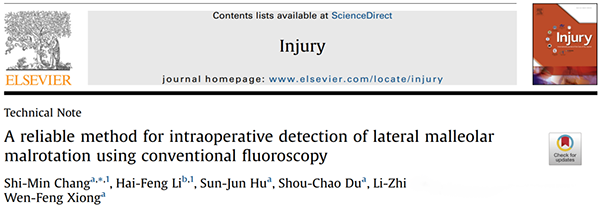
Hwaro hwedzidziso yeiyi nzira ndeyekuti mukuona kwe fluoroscopic kwegumbo, lateral wall cortex ye lateral malleolar fossa inoratidza mumvuri wakajeka, wakatwasuka, wakaoma, wakaenzana ne medial ne lateral cortices ye lateral malleolus, uye iri pakati nepakati kusvika kunze kwechikamu chimwe muzvitatu chemutsetse unobatanidza medial ne lateral cortices ye lateral malleolus.
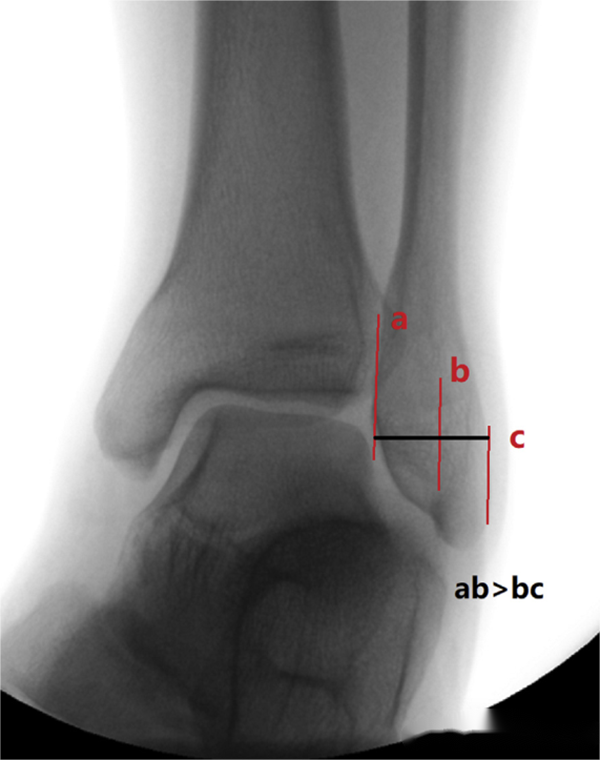
Mufananidzo wekuona kwe fluoroscopic kwegumbo unoratidza hukama huripo pakati pe lateral wall cortex ye lateral malleolar fossa (b-line) uye medial ne lateral cortices ye lateral malleolus (a na c lines). Kazhinji, b-line inowanikwa pamutsetse wekunze wechikamu chimwe muzvitatu pakati pemitsara a na c.
Nzvimbo yakajairika ye lateral malleolus, kutenderera kwekunze, uye kutenderera kwemukati zvinogona kuburitsa mifananidzo yakasiyana mu fluoroscopic view:
- Malleolus yedivi yakatenderera munzvimbo yakajairika**: Mutsetse wedivi redivi redivi une mumvuri we cortical pamadziro edivi redivi re lateral malleolar fossa, wakaiswa pamutsetse wekunze wechikamu chimwe muzvitatu che cortices yepakati nedivi re lateral malleolus.
-Kukanganisika kwekutenderera kwekunze kwe malleolus**: Mutsetse we malleolus divi unoratidzika se "wakapinza-mashizha," mumvuri we cortical uri pa lateral malleolar fossa unonyangarika, nzvimbo ye distal tibiofibular inotetepa, mutsetse weShenton unodzima uye unopararira.
-Kukanganisika kwekutenderera kwemukati kwe malleolus**: Mutsetse we malleolus divi wakaita se "wakaita sechipunu," mumvuri we cortical uri pa lateral malleolar fossa unonyangarika, uye nzvimbo ye distal tibiofibular inokura.
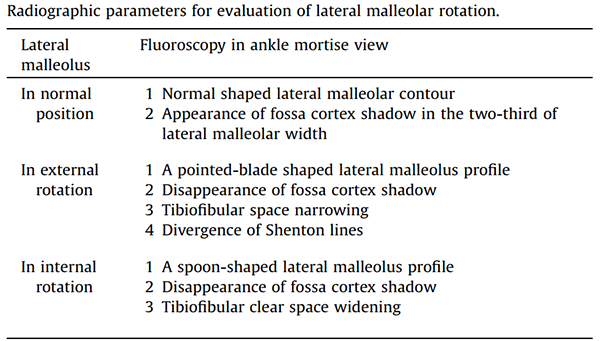
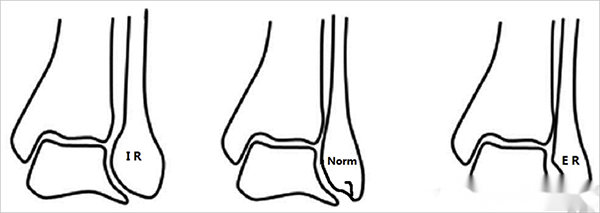
Chikwata ichi chaisanganisira varwere makumi mashanu nevatanhatu vane mapfupa eC-type lateral malleolar fractures pamwe chete nekukuvara kwe distal tibiofibular syndesmosis uye vakashandisa nzira yekuongorora yambotaurwa. Kuongororwazve kweCT mushure mekuvhiyiwa kwakaratidza kuti varwere makumi mana nevana vakawana kudzikira kweanatomic pasina deformities yekutenderera, nepo varwere gumi nevaviri vakasangana nedeformity yekutenderera zvishoma (pasi pe5°), nezviitiko zvinomwe zvekutenderera kwemukati uye zviitiko zvishanu zvekutenderera kwekunze. Hapana zviitiko zvedeformity yekutenderera kwekunze zvine mwero (5-10°) kana zvakanyanya (zvinopfuura 10°) zvakaitika.
Ongororo dzakapfuura dzakaratidza kuti kuongororwa kwekuderedzwa kwekuputsika kwemapfupa emusana kunogona kuenderana nematanho matatu makuru eWeber: kuenzana kwakaenzana pakati penzvimbo dzetibial netalar joint, kuenderera mberi kweShenton line, uye chiratidzo cheDime.
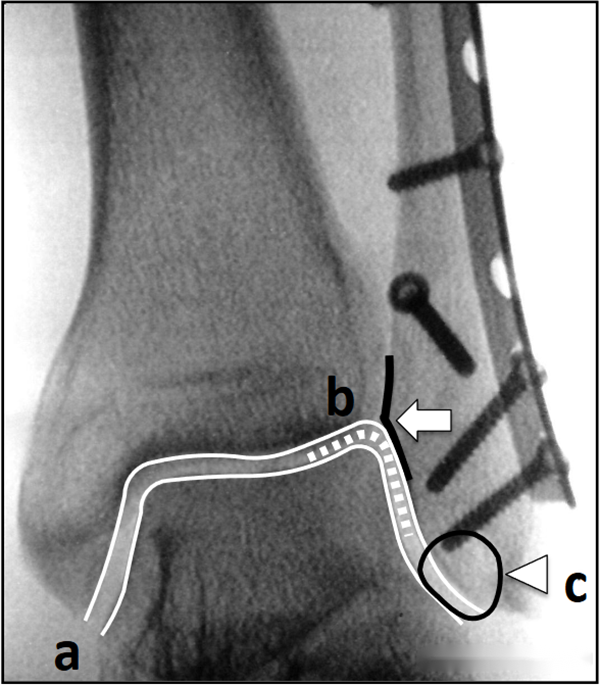
Kudzikiswa kusina kunaka kwe lateral malleolus inyaya yakajairika mukurapa. Kunyange zvazvo kutarisirwa kwakakodzera kuchipihwa pakudzorerwa kwehurefu, kukosha kwakaenzana kunofanira kuiswa pakugadziriswa kwekutenderera. Sejoini rinotakura huremu, chero kuderedzwa kwegumbo kunogona kuva nemigumisiro yakaipa pakushanda kwaro. Zvinotendwa kuti nzira ye fluoroscopic yekuvhiyiwa yakakurudzirwa naProfessor Zhang Shimin inogona kubatsira mukuderedza zvakakwana kuputsika kweC-type lateral malleolar. Iyi nzira inoshanda senzira inokosha yekurapa vari pamberi.
Nguva yekutumira: Chivabvu-06-2024










